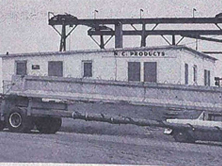 A prestressed concrete girder leaving the Durham plant on a specially designed trailer truck for a bridge under construction over the Cape Fear River in Elizabethtown (Bladen County Bridge 17) in 1957 (source: North Carolina Roadways, March-April 1957).
A prestressed concrete girder leaving the Durham plant on a specially designed trailer truck for a bridge under construction over the Cape Fear River in Elizabethtown (Bladen County Bridge 17) in 1957 (source: North Carolina Roadways, March-April 1957). After trial efforts with block slab and channel beam bridges, the State Highway Department was ready to expand its use of prestressed concrete for a variety of bridge types, including stringers.
In 1957, the department built its first major prestressed concrete bridge, which carried U.S. 701/N.C. 41 over the Cape Fear River at Elizabethtown (Bladen County Bridge 17). The bridge has 98 prestressed concrete, I-shaped beams, each 110-feet-long and weighing 11 tons, cast in the Durham plant of the North Carolina Concrete Products Corporation.
Each beam contained 26 steel cables with approximately five times the strength of ordinary reinforcing steel. The concrete was poured in steel forms around the cables, which were stretched 34 inches by jacks exerting a force of 243 tons. The cables contracted when the tension was released by cutting them at either end of the beam, forcing the concrete together tightly and thus preventing the likelihood that the beam would crack or sag.
The beams, although patterned after national standards, were still an impressive size for the state's first major effort. They were transported from Durham to Elizabethtown on a specially designed trailer truck.
The department quickly adopted the prestressed concrete stringer technology, utilizing it at bridges on the rapidly developing interstate highway system. By 1960, prestressed concrete stringer bridges were well on their way to becoming one of the dominant standard bridge types in the state.
The Historic Bridge Inventory identified nearly 80 examples with dates of construction from 1957 to 1960. Chief state bridge engineer T. B. Gunter, Jr. reported that prestressed concrete stringer bridges had made the cast-in-place, tee-beam bridge practically obsolete. Prestressed concrete allowed "standardization to be utilized to its maximum effect in girder design and details," both from the standpoint of the designing engineer and the casting company.
The introduction of prestressed concrete marked one of the most significant technological changes in standardized bridge construction since the early years of the department. The applications of prestressed concrete from the mid-1950s show important thinking about, and uses of, the new material.